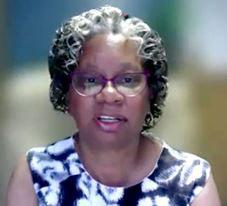Date Posted, by DCP Staff
The NCI Community Oncology Research Program (NCORP) annual meeting for grantees in August 2021 virtually brought together representatives from every NCORP Research Base and Community and Minority Underserved Site to discuss and learn about a range of topics.
A recurring theme was the renewed focus on equity and access to clinical trials through the NCORP network. In opening remarks, NCI Director Ned Sharpless, M.D., said it is important to “mind the gap” to bridge the problems of cancer disparities in clinical trials and prevention, especially where a population that is difficult to study is critical to cancer clinical trials.

Worta McCaskill-Stevens, M.D., M.S.
NCORP is a leader in incorporating cancer disparities into research, he said. “The work that NCORP does is really vital to cancer care in the nation.” To achieve health equity, NCI has to “bake it into everything we do,” he said. Acknowledging structural racism in biomedical research, Dr. Sharpless said access to clinical trials is an important proxy for good health care in the United States. NCI must address minority participation in clinical trials, and NCORP is one of the best mechanisms across NIH doing just that. NCI is looking at duplicating some of the successes of NCORP across NCI and NIH in more generalizable data because the goal is not really about hitting a target, but about getting better outcomes for patients, and with the same access to care, people can have the same outcomes, Dr. Sharpless said.
He said NCI is proud that NCORP accrual has rebounded and that enrollment was higher in 2020 than in 2018 and 2019, but there remains real concern about the impact of the COVID-19 pandemic on underserved populations. “We can’t make progress if we leave huge portions of our society behind. We have to take collective action to make sure all Americans benefit from cancer research,” he said.
“What’s in a year? Science mattered. Commitment to our patients, access to care, equity,” said NCORP Director Worta McCaskill-Stevens, M.D., M.S. “2020 should be a year to remember.”
Successful disparities research examples were provided by Dr. McCaskill-Stevens, who noted that Research Bases are working together using pooled analyses for targeted populations across several studies including: URCC-21038, “Disparities in Results of Immune Checkpoint Inhibitor Treatment (DIRECT), a Prospective Cohort Study of Cancer Survivors Treated with anti-PD-1/anti-PD-L1 Immunotherapy in a Community Oncology Setting,” in which the African-American community is a focus because there are data to suggest that there are strong pro-inflammatory responses.
A second trial, SWOG-2013, “Immune Checkpoint Inhibitor Toxicity (I-CHECKIT), a Prospective Observational Study,” is looking at developing a predictive model of toxicities. Also, the use of diversity supplements to increase diversity in the workforce is exemplified by WF-1901, “Internet-delivered Management of Pain Among Cancer Treatment Survivors,” she said.
Authentic Engagement and Building Trust
In a keynote, Sandra Millon Underwood, Ph.D., R.N., F.A.A.N., addressed the relevance of inclusion, equity and authentic engagement in pursuing equitable representation in community cancer research. There have been thousands of articles published, and the research is clear that there is more to do to increase the engagement of minorities, although NCI has been in the forefront of engaging, underrepresentation in clinical cancer research continues, she said.

Sandra Millon Underwood, Ph.D., R.N., F.A.A.N.
Among the critical barriers to minority participation in clinical trials, Dr. Millon Underwood said, continues to be a lack of trust in researchers and the research process. Another challenge is the clinical trial process, especially recruitment; if minorities have not been invited and informed sufficiently, then the answer is already no to joining a trial, she said. Opportunities for the participants often are not clearly articulated, and they may feel coerced, rather than being assisted in making their own informed decisions.
At the same time, authentic engagement and respecting the opinions of the research team is critical to increasing minority accrual, she noted. In particular, the one group of individuals most respected and yet underutilized are the clinical research nurses, she said. There is no other group more highly regarded than professional nurses; they understand communities in a way that others on the team do not, and are trusted by communities.
Another important issue is that all too often research teams and individuals do not understand the communities they are targeting; they have not visited or engaged with them before they ask for involvement in a clinical trial, so research teams need to be better educated before they ask for involvement in community clinical research, she said.
Building trust between minorities and researchers “can be done, it must be done, and it is being done,” Dr. Millon Underwood said. Some of the actionable ways to improve inclusion and engagement of minority populations are: establish a presence and cultivate relationships with community groups; engage and support community efforts to address ongoing needs of the target community and ask to present information sessions in communities; create community advisory teams representing populations under study; identify key community leaders and ask for feedback on the study; solicit input from community advisory teams on study design, implementation and reporting and engage trusted clinicians, nurses and community health workers from the population under study in those same areas.
A breakout session on “Achieving Diversity in Clinical Trial Accrual: The Time has Come” focused on barriers and challenges to accrual of minority, rural, adolescents and young adults (AYA), and older adult patients in NCI clinical trials. Strategies used by NCORP Community and Minority Underserved Sites to address accrual of these underrepresented populations were discussed.
Beyond Black and White
“Disparities is beyond black and white,” Lucile L. Adams-Campbell, Ph.D., chair of the Alliance Research Base Health Disparities Committee, said. Groups that can experience disparities include: racial and ethnic minorities; people with lower socio-economic status as measured by education level and income; geographically defined groups; AYA populations; much older adults; females; the disabled; and sexual and gender minorities. “We need to make certain we develop studies that everybody can participate in,” she said. One Alliance study, for example, provides cell phones and cell service when needed. Another trial from Alliance is increasing engagement of socioeconomically disadvantaged patients and their family members in breast cancer surgery decisions. The Research Base tries to develop studies that various groups of people will want to both participate in and be eligible for.

Lucile L. Adams-Campbell, Ph.D.
From the Research Base perspective, there are several operational strategies shown to address equitable representation in clinical trials, Dr. Adams-Campbell said, such as identifying translational services for non-English speakers. Tracking minority inclusion accrual through regular reports was also mentioned. The Research Base is in process of developing weekly enrollment reports by race/ethnicity, urban vs. rural and age (AYA and older adult) for Alliance sites to access and track enrollments in real time, to meet study specified accrual goals. Another area is assigning the health disparities co-chairs to studies in development to focus on and develop minority enrollment strategies. Cross-committee and disease group collaboration strategies and educational symposiums are also working to support protocol development.
Although we are in an age of rapid fire discovery, if we truly believe that the best care is through a clinical trial, then we haven’t truly realized the opportunity to offer the best treatment to the majority of our patients, noted Ray Osarogiagbon, M.D., chief scientist, Baptist Memorial Healthcare Corporation and Director and Principal Investigator of the Baptist Healthcare/Mid-South Minority Underserved NCORP. Citing data from a recent SWOG analysis, primary barriers to clinical trials participation are structural (56%), then clinical ineligibility (22%), and the potential for discussion about trial participation (22%). Disparities disappear when eligibility requirements are met for potential participants, he said.
Dr. Osarogiagbon emphasized that we must question the messaging around bringing clinical trials to the community, specifically as it relates to engaging and addressing barriers for private practice providers with a “leave-me-alone” mindset who have unwittingly chosen not to put patients on clinical trials. Relatedly, examining at structural barriers and how to shift the paradigm was a tangible outcome of the recent SWOG symposium focused on improving representation in NCORP clinical trials, said Dr. Osarogiagbon, who recently became Board Chair of the Hope Foundation for Cancer Research. The foundation announced its NCORP Pilot Grant Program to issue up to $50,000 in direct costs for projects aimed at establishing infrastructure or testing an intervention to improve access for underserved populations through a competitive, peer-reviewed process, and a deadline to apply by December 1, 2021.
If you would like to reproduce some or all of this content, see Reuse of NCI Information for guidance about copyright and permissions. Please credit the National Cancer Institute as the source and link directly to the blog post using the original title, for example: "Equity and Access to Trials Highlight the 2021 NCORP Grantee Meeting was originally published by the National Cancer Institute." For questions, contact us at CancerPreventionBlog@mail.nih.gov.
